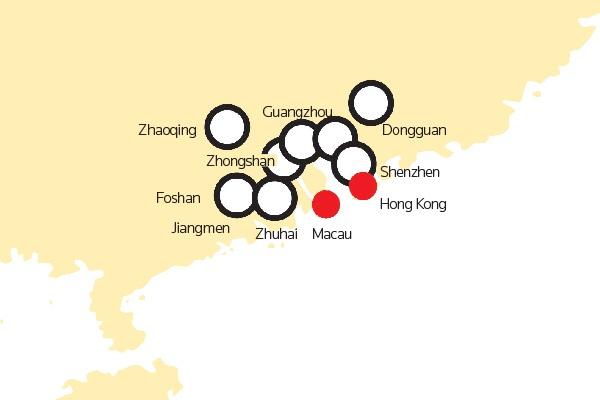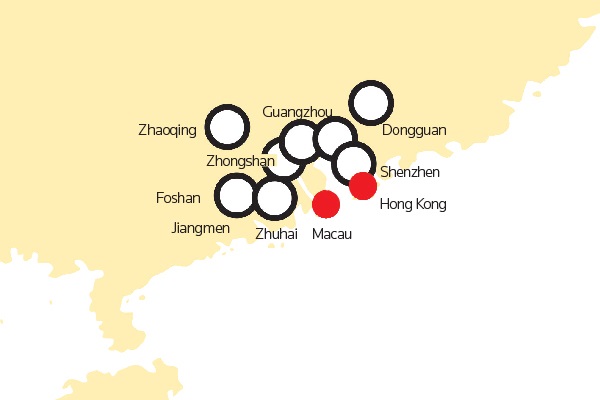
The 56,000 sq. km Guangdong-Hong Kong-Macao Greater Bay Area is home to more than 69 million people, and an increasing number of law firms. Here’s what 2019 could look like for the region’s legal industry.
In simple words, the concept of “microtrend”, coined by US writer and futurist Mark Penn, means a trend that influences trends and a change that brings about changes.
In its New Year speech this year, a knowledge service provider described a microtrend as follows: the world can be seen as a game of “domino” tiles; aslong as a small trembling knocks down one tile, this microtrend will push a bigger trend which will in turn trigger another even bigger trend, eventually resulting in a “monster” rolled before our eyes through a series of chain reactions.
However, a microtrend is not the initial stage of a megatrend and may not eventually grow into a megatrend on its own.
Having said that, the power and energy of a microtrend are precisely what activates a chain of reactions and brings about a new landscape.
It is by borrowing this concept that we present the second part of our “Southern China Legal Market Report” series, trying to see both the “present” and the “future” of the legal market of the Guangdong-Hong Kong-Macao Greater Bay Area (“Greater Bay Area”) from the eyes of the managing partners of law firms that are different in size, management system, business focus and stage of development.
Microtrend 1: specialized and centralized jurisdiction
In his New Year’s message, Jiang Yong, Founding and Managing Partner of TianTong Law Firm, first asked the question of “Is the world going to be ok in 2019?”. Undoubtedly, China’s economy was faced with downward pressure in 2018, and the external environment is becoming increasingly complicated and grim. However, China is still in a period of important strategic opportunities where great achievements can be made in terms of development and where deepening reform and opening-up initiatives continue to unleash the country’s development potential.
“The legal industry is closely related to national social and economic development, and the ‘grey rhinos’ of economic risks are bound to hit the legal services market. However, to the extent that contentious mandates fall, non-contentious engagements will rise. Our prediction is that against the backdrop of ‘grey rhinos’, business opportunities for dispute resolution will stand out on China’s legal services market, especially in Shenzhen within the Greater Bay Area,” Jiang told ALB.
In 2018, TianTong completed its “1+6” national layout of “head office + branch offices” by opening three new offices, a swift response to the six circuit courts established by the Supreme People’s Court in Shenzhen, Shenyang, Nanjing, Zhengzhou, Chongqing and Xi’an. According to Jiang, “With the new layout, we hope to link up the vertical chain of different levels of adjudication applicable to different cases, and build lateral cooperation among various practice groups in different locations to provide clients with dispute resolution services of even higher quality.”
The Shenzhen office represents TianTong’s sole presence in the Greater Bay Area and is also the place where TianTong responds to the “explosion of litigations”. In the first article of the “Southern China Legal Market Report” series, Jiang pointed out that there would be exponential growth for seven types of cases in Shenzhen, and that the number, type, subject matter value and difficulty of these cases of commercial dispute resolution will all be among the highest in the country, exactly the reason why the Supreme People’s Court has decided to establish the First Circuit Court and the First International Commercial Court in Shenzhen.
As Jiang put it, “The fact that the Supreme People’s Court has assigned the judges who are most experienced in commercial hearings to Shenzhen shows that commercial activities in Southern China, especially in the Greater Bay Area, are both very active and the most innovative. In addition, the First International Commercial Court is also a bold and innovative attempt to combine mediation, arbitration and hearings under one roof and make first-instance hearings the final instance. This is unprecedented in litigation procedures.”
It is reported that the First International Commercial Court will recognize enforcement by foreign arbi¬tration institutions with which it has entered into partnership and will also accept applications for litigation pres-ervation from foreign arbitration institu¬tions. This court will not only hear cases where one party is based in China; its establishment will also attract more international arbitration institutions to look for cooperation. Foreign parties may also choose to resolve their disputes in this court in Shenzhen.
Microtrend 2: continuing integration of law firms
In recent years, the increasing number of offices set up by national firms in Shenzhen has led to intensi¬fying competition. In response, local Shenzhen law firms have been going through constant integration. Zhang Jian, Managing Partner of Dentons Shenzhen, explained that “Small and medium-sized firms in Shenzhen will need to either develop themselves into larger firms that can pool talents and harness the benefits of specialization, or return to sole proprietorships to ensure simple and efficient management. Small and medium-sized firms based purely on commission sharing no longer enjoy any survival advantage.”
Li Gang, director of the management committee of Kingpound Law Firm, also pointed to the fierce “re-shuffling” experienced by local firms in Guangzhou in recent years. With law firms from Beijing, Shanghai and Hong Kong all heading to Guangzhou, local firms have been caught in the crossfire, forcing them to step up their efforts to “go out” or seek merger and reorganization to get a better market share.
As planned, Kingpound opened two offices in Huadu and Baiyun in Guangzhou last year. According to Li, the firm will continue to open new offices in other cities in the Greater Bay Area in the next two to three years to deepen its involvement in the legal services market in the region. In view of the inter-regional conflicts brought about by the three different legal systems practiced in the Greater Bay Area, Li predicted an increasing number of civil disputes, such as legal issues arising out of juxtaposed controls after the opening of the Guangzhou-Shenzhen- Hong Kong high-speed railway, issues of vehicle management after the Hong Kong-Zhuhai-Macao Bridge is put into operation, purchase of Mainland properties by Hong Kong compatriots, marriage between Macao compatriots and Mainland residents, etc.
Li stressed that in addition to aiming to become a regional heavyweight, Kingpound was also exploring the possibil¬ities of going to joint ventures. For example, the firm is contemplating about how to help Hong Kong and Macao law firms to capture more business opportunities in the Mainland, and is also exploring whether local firms may employ overseas-registered lawyers from Hong Kong and Macao to practice in the Mainland to better provide Mainland clients with services related to Hong Kong and Macao laws. This type of two-way business flow will be both a breakthrough and an opportunity for Kingpound.
In addition, China Commercial Law Firm also revealed its plan to open an office in Hong Kong in 2019, while Guangdong Grand & Holders Law Firm is looking for deeper engagement in Shenzhen.
JunHe LLP also has presence in Guangzhou, Shenzhen, Hong Kong and Haikou. Zhang Ping, Managing Partner of JunHe’s Guangzhou office, told ALB that the top priority for the four offices was to enhance integration and quickly have in place top teams capable of responding to the business opportunities that policies of the Greater Bay Area can bring about.
Microtrend 3: bigger stage for lawyers
China’s legal services market is expected to double on the current base of RMB 90 billion in the next ten years, and all performance indicators will achieve continuous improvement. Guangdong, as a province with a large population of lawyers, will witness not only an increase in the number of lawyers in the next few years, but also the enhancement in the professionalization and international¬ization of the legal team and the overall development of the system of lawyers, predicted Gao Shu, former President of the Shenzhen Lawyers Association and the Chief Executive Partner of China Commercial Law Firm.
Gao believed that in the future economic development pattern, a large integration must be carried out to accommodate the volume of market development and that the Greater Bay Area itself is a place where all these grand schemes are being accommodated, the process of which will promote the renewal of the legal services industry.
Lawyers must both focus on macro-level inter-regional legal conflicts and keep pace with the times at the micro level to meet the complex, new and difficult legal issues that keep emerging under new business models. Be it the volume, contents or areas of business, the economic aggregate and develop¬ment potential of the Greater Bay Area will undoubtedly open up unlimited business opportunities for the legal services market.
“As a hub of scientific and technolog¬ical innovation, Shenzhen’s demand for intellectual property (“IP”) services has reached a very large volume, but the capacity to provide IP legal services in the city is far from ideal. The problem at the moment is that there are not enough lawyers practicing high-end IP law and that practice in this area is not specialized and in-depth enough, all of which need to be addressed and rectified,” emphasized Gao.
“Shenzhen is also a hot spot for dispute resolution. Cases of commercial dispute resolution coming to Shenzhen boast the most variety in categories, the largest in subject matter value, the latest in types, the highest in the level of difficulty and the most complicated in the corresponding dispute resolu¬tion procedures, requiring lawyers to be extremely familiar with, and highly skilled in utilizing, the process, and to have sufficient knowledge reserves for all types of new cases. For example, to handle blockchain and cryptocurrency disputes, lawyers must first become experts in those fields themselves so as to better help their clients.” Jiang said.
聚焦2019大湾区法律市场
面积约56000平方公里的粤港澳大湾区,人口约6900多万人, 律所数量也稳定增长。本文将聚焦2019年大湾区法律市场的态势与动向。
美国作家马克▪佩恩是首次提出“小趋势”概念的未来学家。“小趋势”简言之就是:影响趋势的趋势,带来变化的变化。
某知识服务商在今年跨年演讲中对“小趋势”做了形象比喻:世界可理解成一组多米诺骨牌,其中只要有一个小小颤动碰倒了一张牌,这个极小的趋势就会推动大一点的趋势,接着又引发另一个更大的趋势,最终经由一连串连锁反应“滚”成了“庞然大物”抵达我们面前。
但“小趋势”不是大趋势的初级阶段,它本身也未必能长成大趋势,但它的威力与能量恰恰是启动连锁反应、带来新的景观。
借用这个概念,我们推出“华南法律市场报告”系列的第二篇,试图从不同规模、不同管理体制、不同业务定位、不同发展阶段的律所管理合伙人眼中,看到大湾区法律业态的“进行时”与“将来时”可能呈现的景象。
小趋势一:专业化集中管辖
天同律师事务所首席合伙人蒋勇律师在其新年献词中首先抛出了“2019,这个世界会好吗?”的发问。无疑,2018年中国经济面临下行压力,外部环境日益复杂严峻,但中国发展仍处于大有作为的重要战略机遇期,不断深化的改革开放持续释放着发展势能。
“律师行业与国家社会经济发展状况紧密相关,经济的‘灰犀牛’势必冲击到法律服务领域,但诉讼与非诉业务在某种程度上是此消彼长的。我们预测‘灰犀牛’下的中国法律服务,争议解决业务机会将更大量爆发,特别是湾区下的深圳。”蒋勇律师告诉ALB。
2018年,天同完成了“1+6”的“总部+分所”的全国布局,仅去年一年就连开3家分所,是对最高人民法院相继在深圳、沈阳、南京、郑州、重庆、西安设立6个巡回法庭的快速反应。蒋勇律师表示,“在新的布局中,我们希望打通不同案件审理层级的纵向链条,构建各个地域业务团队的横向协同 ,为客户打造更加极致的争议解决法律服务。”
深圳办公室是天同在湾区的唯一部署, 也是天同应对“诉讼爆炸”的多发地。蒋勇律师在“华南市场报告”系列的第一篇中曾指出深圳将有7大类案件呈井喷式爆发, 且这些商事争议解决案件的数量、类型、标的额、疑难程度均居全国之最,这正是最高院第一巡回法庭、第一国际商事法庭设在深圳的原因。
蒋勇律师指出,“最高院把在商事审判方面最精英的法官派到深圳了,说明华南地区特别是湾区的商事活动是非常活跃的,同时也是最具创新性的。另外,第一国际商事法庭也是个大胆创新,把调解、仲裁、审判结合在一起,实行一审终审, 这在诉讼程序上是前所未有的。”
据悉,第一国际商事法庭承认与其有合作关系的国外仲裁机构的执行,接受国外仲裁机构的诉讼保全申请。该法庭的设立将不仅审理在中国的一方当事人,还会吸引更多的国际仲裁机构建立合作,国外当事人也可选择在深圳国际商事法庭解决纠纷。
小趋势二:律所整合仍将持续
近些年,由于全国所在深圳的办公室越来越多,竞争愈加激烈,深圳本土所的重整一直进行中。大成律师事务所深圳办公室管理合伙人张健律师指出,“深圳的很多中小型律所要么开始选择做大规模,以形成人才集聚效应和专业分工便利;要么选择做成精品所、个人所,确保专业细分优势和管理简单高效,纯提成制的中小所未来的发展的优势不明显。”
广州金鹏律师事务所管委会主任李纲律师指出广州本土所这几年也在激烈“洗牌” ,北京所、上海所“南下”,香港所“北上”, 广州本土所遭遇“南北夹击”,这种竞争局势倒逼广州律所要加强“走出去”,或寻求合并重组拿到更好的市场份额。
按照计划,金鹏去年在广州花都和白云开设了两家分所。据李纲律师介绍,未来两三年金鹏还会在湾区其他城市继续开设新办公室,深耕湾区下的法律服务市场。鉴于湾区带来的区际法律冲突,李纲律师预见三个法系下的民事纠纷将越来越多, 比如广深港高铁开通后一地两检的法律层面问题,港珠澳大桥开通后的车辆管理问题,香港同胞到内地买房或者澳门同胞来内地结婚等等。
李纲律师强调,金鹏除了要做区域大所,也在探讨如何做联营律所,比如怎么帮到香港律所和澳门律所在内地争取更多业务机会,同时也探讨本土所是否也能聘用港澳的注册海外律师来内地执业,更好地为内地客户提供香港法服务和澳门法服务,这种双向的业务流对金鹏来说既是突破也是机遇。
此外,广东华商律师事务所透露2019年计划在香港开设分所,广东广悦律师事务所则进一步在深圳布局。
君合律师事务所在广州、深圳、香港、海口四地也均设有办公室。君合广州管理合伙人张平律师告诉ALB,四地办公室会在原有的一体化的基础上进一步加强联动,并在君合整体平台上有针对性地配置资源,以迎接大湾区发展带来的业务机会。
小趋势三:律师将大有作为
未来10年,中国法律服务市场的体量应在现有900亿的基础上翻番。各方面指标会呈现平稳跨越。广东作为律师人口大省,未来几年将不仅实现律师人数增长,律师整体的专业化、国际化、体制也将一并提升——前深圳律师协会会长、广东华商律师事务所首席合伙人高树律师这样预测。
高树律师认为,在将来的经济发展格局中,必须要进行一个大的融合才能容纳发展的体量,大湾区就是这个“大”的容纳把这些体量都放进去,放进去的过程会催生法律服务业的更新换代。
律师既要着眼宏观的区际法律冲突,又要在微观层面与时俱进、满足新业态下层出不穷的复杂、新型、疑难法律问题。无论从业务量、业务内容、还是业务领域来看,湾区的经济总量和发展潜力都将为法律服务市场撬开无限商机。
“深圳作为科技创新之都,对知识产权的需求已达到了非常大的量,但深圳知识产权法律业态还远未成气候,从事高端知识产权业务的律师数量不够多、业态不够稳定、还应向横向和纵深拓展,这些都是亟需补课和突破的。”高树律师强调。
“深圳也是争议解决的‘热土’,这里的商事争议解决案件种类最多、标的额最大、类型最新、疑难案件数量最多,相应的争议解决程序也是比较复杂的,这就要求律师要非常精通程序并娴熟运用,并对各类新型案件做好充分的知识储备,比如处理区块链、加密货币纠纷时,律师要先成为这个领域的专家才能更好地帮助当事人。”蒋勇律师谈到。
To contact the editorial team, please email ALBEditor@thomsonreuters.com.



